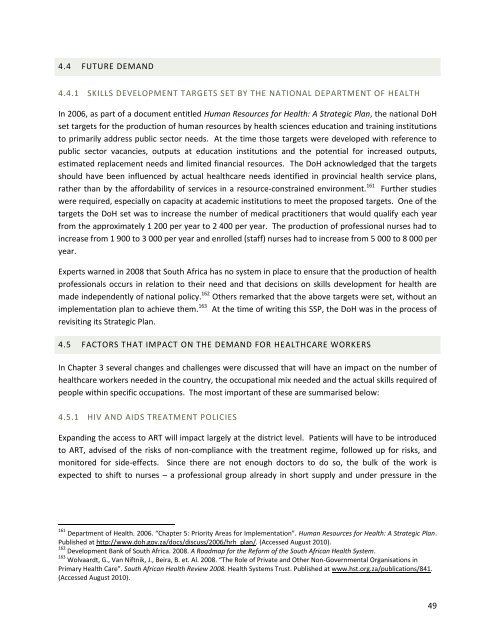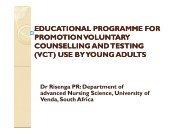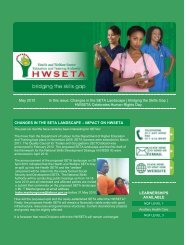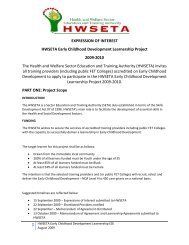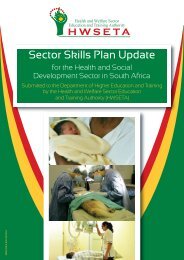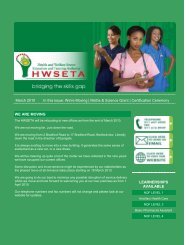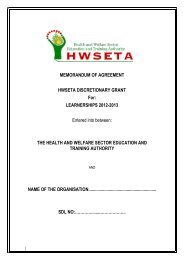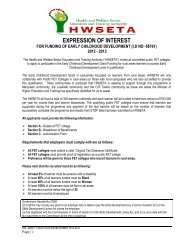sector skills plan for the health sector in south africa
sector skills plan for the health sector in south africa
sector skills plan for the health sector in south africa
Create successful ePaper yourself
Turn your PDF publications into a flip-book with our unique Google optimized e-Paper software.
4.4 FUTURE DEMAND<br />
4.4.1 SKILLS DEVELOPMENT TARGETS SET BY THE NATIONAL DEPARTMENT OF HEALTH<br />
In 2006, as part of a document entitled Human Resources <strong>for</strong> Health: A Strategic Plan, <strong>the</strong> national DoH<br />
set targets <strong>for</strong> <strong>the</strong> production of human resources by <strong>health</strong> sciences education and tra<strong>in</strong><strong>in</strong>g <strong>in</strong>stitutions<br />
to primarily address public <strong>sector</strong> needs. At <strong>the</strong> time those targets were developed with reference to<br />
public <strong>sector</strong> vacancies, outputs at education <strong>in</strong>stitutions and <strong>the</strong> potential <strong>for</strong> <strong>in</strong>creased outputs,<br />
estimated replacement needs and limited f<strong>in</strong>ancial resources. The DoH acknowledged that <strong>the</strong> targets<br />
should have been <strong>in</strong>fluenced by actual <strong>health</strong>care needs identified <strong>in</strong> prov<strong>in</strong>cial <strong>health</strong> service <strong>plan</strong>s,<br />
ra<strong>the</strong>r than by <strong>the</strong> af<strong>for</strong>dability of services <strong>in</strong> a resource-constra<strong>in</strong>ed environment. 161 Fur<strong>the</strong>r studies<br />
were required, especially on capacity at academic <strong>in</strong>stitutions to meet <strong>the</strong> proposed targets. One of <strong>the</strong><br />
targets <strong>the</strong> DoH set was to <strong>in</strong>crease <strong>the</strong> number of medical practitioners that would qualify each year<br />
from <strong>the</strong> approximately 1 200 per year to 2 400 per year. The production of professional nurses had to<br />
<strong>in</strong>crease from 1 900 to 3 000 per year and enrolled (staff) nurses had to <strong>in</strong>crease from 5 000 to 8 000 per<br />
year.<br />
Experts warned <strong>in</strong> 2008 that South Africa has no system <strong>in</strong> place to ensure that <strong>the</strong> production of <strong>health</strong><br />
professionals occurs <strong>in</strong> relation to <strong>the</strong>ir need and that decisions on <strong>skills</strong> development <strong>for</strong> <strong>health</strong> are<br />
made <strong>in</strong>dependently of national policy. 162 O<strong>the</strong>rs remarked that <strong>the</strong> above targets were set, without an<br />
implementation <strong>plan</strong> to achieve <strong>the</strong>m. 163 At <strong>the</strong> time of writ<strong>in</strong>g this SSP, <strong>the</strong> DoH was <strong>in</strong> <strong>the</strong> process of<br />
revisit<strong>in</strong>g its Strategic Plan.<br />
4.5 FACTORS THAT IMPACT ON THE DEMAND FOR HEALTHCARE WORKERS<br />
In Chapter 3 several changes and challenges were discussed that will have an impact on <strong>the</strong> number of<br />
<strong>health</strong>care workers needed <strong>in</strong> <strong>the</strong> country, <strong>the</strong> occupational mix needed and <strong>the</strong> actual <strong>skills</strong> required of<br />
people with<strong>in</strong> specific occupations. The most important of <strong>the</strong>se are summarised below:<br />
4.5.1 HIV AND AIDS TREATMENT POLICIES<br />
Expand<strong>in</strong>g <strong>the</strong> access to ART will impact largely at <strong>the</strong> district level. Patients will have to be <strong>in</strong>troduced<br />
to ART, advised of <strong>the</strong> risks of non-compliance with <strong>the</strong> treatment regime, followed up <strong>for</strong> risks, and<br />
monitored <strong>for</strong> side-effects. S<strong>in</strong>ce <strong>the</strong>re are not enough doctors to do so, <strong>the</strong> bulk of <strong>the</strong> work is<br />
expected to shift to nurses – a professional group already <strong>in</strong> short supply and under pressure <strong>in</strong> <strong>the</strong><br />
161 Department of Health. 2006. “Chapter 5: Priority Areas <strong>for</strong> Implementation”. Human Resources <strong>for</strong> Health: A Strategic Plan.<br />
Published at http://www.doh.gov.za/docs/discuss/2006/hrh_<strong>plan</strong>/. (Accessed August 2010).<br />
162 Development Bank of South Africa. 2008. A Roadmap <strong>for</strong> <strong>the</strong> Re<strong>for</strong>m of <strong>the</strong> South African Health System.<br />
163 Wolvaardt, G., Van Niftnik, J., Beira, B. et. Al. 2008. “The Role of Private and O<strong>the</strong>r Non-Governmental Organisations <strong>in</strong><br />
Primary Health Care”. South African Health Review 2008. Health Systems Trust. Published at www.hst.org.za/publications/841.<br />
(Accessed August 2010).<br />
49


